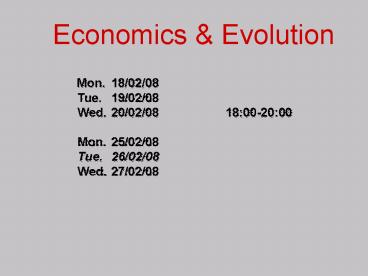Economics - PowerPoint PPT Presentation
1 / 43
Title: Economics
1
Economics Evolution
Mon. 18/02/08 Tue. 19/02/08 Wed. 20/02/08
1800-2000 Mon. 25/02/08 Tue.
26/02/08 Wed. 27/02/08
2
Economics Evolution
http//www.wiwi.uni-bonn.de/shaked/Evolution-TLV-2
008/
http//www.wiwi.uni-bonn.de/shaked/Evolution-TLV-2
008/
3
GENERAL 1. R. DAWKINS The Selfish Gene, OUP
1976 2. J. MAYNARD SMITH Evolution and the
Theory of Games, CUP 1982 3. T. SCHELLING
Micromotive and Macrobehavior, W.W. Norton
1978 LEARNING PROCESSES BEST RESPONSE DYNAMICS
(COURNOT), FICTITIOUS PLAY, SOCIAL LEARNING 4.
K. BINMORE Fun and Games, Heath 1992 5. D.
FUDENBERG, D. K. LEVINE The Theory of Learning
in Games, MIT Press 1998 6. D. MONDERER, D.
SAMET, AND A. SELA Belief Affirming in
Learning Processes, JET 1997 REPLICATOR
DYNAMICS, EVOLUTIONARILY STABLE STRATEGY
(E.S.S.) 7. J. Weibull Evolutionary Game Theory,
MIT 1995 LOCAL INTERACTION 8. ESHEL I., L.
SAMUELSON AND A. SHAKED Altruists Egoists and
Hooligans in a Local Interaction Model, American
Economic review, 1998.
4
FURTHER READING 1. J. HOFBAUER, K. SIGMUND
Evolutionary Games and Replicator Dynamics, CUP
1998 (2002) 2. K. SIGMUND Games of Life,
Explorations in Ecology, Evolution and
Behavior, Penguin 1993 3. T. BERGSTROM Storage
for Good Times and Bad Of Rats and Men,
Santa Barbara, mimeo, 1997 (www.econ.ucsb.edu/ted
b/Evolution/store.pdf) 4. T. BORGERS, R. SARIN
Naive Reinforcement Learning with
Endogeneous Aspirations, JET 1998 COOPERATION 5
. R. AXELROD The Evolution of Cooperation, Basic
Books 1985 6. L. SAMUELSON, K. BINMORE
Evolutionary Stability in Repeated Games Played
by Finite Automata, JET 1992 7. ESHEL I., E.
SANSONE AND A.SHAKED The Emergence of Kinship
Behavior in Structured Populations of Unrelated
Individuals, International Journal of Game
Theory, 1999. 8. ESHEL I., D. HERREINER, L.
SAMUELSON, E. SANSONE AND A. SHAKED Cooperation,
Mimesis and Local Interaction Sociological
Methods and Research, 2000. 9. ESHEL I. AND A.
SHAKED Partnership Journal of Theoretical
Biology, 2002.
5
Economics Evolution
6
Cournot Game
- 2 players
- Each chooses quantity qi 0
- Player is payoff is qi(1- qi qj )
- Player 1s best response (given q2 )
Inverse demand (price) No cost
BR1
BR2
7
BR1
BR2
8
A Dynamic Process
9
(No Transcript)
10
A steady state
2 - 2 0
4 - 1 3
11
Define
The difference equation
becomes
or
12
Convergence to Nash Equilibrium
Do the players' beliefs make sense ?
13
C
B
A
14
Do the players' beliefs make sense ?
Change the model Players are very rarely allowed
to revise their strategy. At period t, player i
is allowed to choose his best response with
probability p, where p 0. (a stochastic
process)
OR The players alternate
15
(No Transcript)
16
Continuous Time
Let the time interval between periods approach 0.
A change of notation
In time ?t the individual advances only part of
the path
17
Continuous Time
Let the time interval between periods approach 0.
A change of notation
18
Continuous Time
19
(No Transcript)
20
(No Transcript)
21
Cournot model, Three Firms
discrete time
22
Cournot model, Three Firms
discrete time
does not converge !!!!!
Continuous time
Similarly for i 2, 3. Add the
three equations
23
Cournot model, Three Firms
Continuous time
24
Cournot model, Three Firms
Continuous time
25
Cournot model, Three Firms
Continuous time
26
Fictitious Play
- Two players repeatedly play a normal form game
- Each player observes the frequencies of the
strategies played by the other player in the past
(fictitious mixed strategy) - Each player chooses a best response to the
fictitious mixed strategy of his opponent.
27
n
n
Updating the frequencies (of the n strategies)
or
28
An Example
Let p(t),q(t) be the frequencies of the second
strategy played by played 1,2
Analysis of the stage-game
?BR1
? BR2
Nash Equilibrium p q 1/2
29
An Example
As long as ( p(t) , q(t) ) is in the first
quadrant,
the best responses are ( B , A ).
30
An Example
the best responses are ( B , A )
p(t) increases, q(t) decreases (with t)
31
An Example
32
An Example
33
An Example
34
1
An Example
q(t)
0
1
1 - p(t)
35
1
An Example
q(t)
0
1
1 - p(t)
Best responses in this quadrant are (B , B )
p(t) , q(t) increase (with t )
36
1
B
An Example
(A , B )
(A , A )
(B , B )
(B , A )
0
1
A
B
Best responses in each quadrant are
37
1
An Example
(A , B )
(A , A )
(B , B )
(B , A )
0
1
38
1
An Example
(A , B )
?
(A , A )
at
(B , B )
(B , A )
Does it converge?
0
1
Does convergence mean that they play the
equilibrium?
at1
converges !!!
0
39
1
An Example
(A , B )
(A , A )
(B , B )
(B , A )
0
1
What does an outside observer see?
(B , A )
(B , B )
(A , B )
(A , A )
How much time is spent in each quadrant ???
40
1
An Example
(A , B )
(A , A )
(B , B )
(B , A )
time spent in each quadrant
0
1
(to be used later)
41
1
An Example
(A , B )
(A , A )
(B , B )
(B , A )
time spent in each quadrant
0
1
42
1
An Example
(A , B )
(A , A )
(B , B )
(B , A )
time spent in each quadrant
0
1
43
1
An Example
(A , B )
(A , A )
(B , B )
(B , A )
time spent in the first quadrant
0
1
analogously































